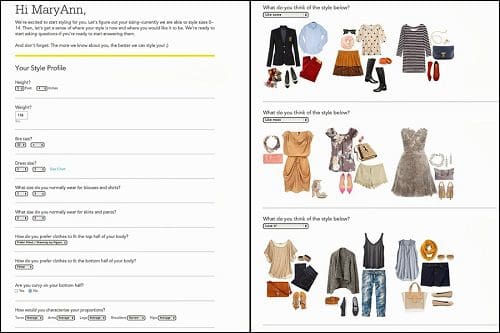Interview: Brad Klingenberg, StitchFix on Building Analytics-powered Personal Stylist
We discuss StitchFix, how it leverages Analytics, understanding customer preferences, and pros-and-cons of involving human judgement in the recommendation process.
 Brad Klingenberg is the Director of Styling Algorithms at Stitch Fix in San Francisco. His team uses data and algorithms to improve the selection of merchandise sent to clients. Prior to joining Stitch Fix Brad worked with data and predictive analytics at financial and technology companies. He studied applied mathematics at the University of Colorado at Boulder and earned his PhD in Statistics at Stanford University in 2012.
Brad Klingenberg is the Director of Styling Algorithms at Stitch Fix in San Francisco. His team uses data and algorithms to improve the selection of merchandise sent to clients. Prior to joining Stitch Fix Brad worked with data and predictive analytics at financial and technology companies. He studied applied mathematics at the University of Colorado at Boulder and earned his PhD in Statistics at Stanford University in 2012.
Here is my interview with him:
Anmol Rajpurohit: Q1. What does Stitch Fix do? Why is Analytics important for Stitch Fix?
 Brad Klingenberg: Stitch Fix is an online personal styling service for women. Clients sign-up online and tell us about their style and fit preferences. We then choose five items that we think she will love and send them to her in a shipment that we call a “fix". The key is that unlike traditional e-commerce where a client shops for themselves, we select all of the items for the client, acting as their personal stylist. After we ship the items to the client she tries them on at home and sends back whatever she doesn’t want to keep. There is a $20 styling fee to receive a fix, but the cost is applied towards her purchase if she keeps at least one item. The client can send any or all of the merchandise back and we pay for shipping both ways -- therefore, it's critical we find things that will delight her.
Brad Klingenberg: Stitch Fix is an online personal styling service for women. Clients sign-up online and tell us about their style and fit preferences. We then choose five items that we think she will love and send them to her in a shipment that we call a “fix". The key is that unlike traditional e-commerce where a client shops for themselves, we select all of the items for the client, acting as their personal stylist. After we ship the items to the client she tries them on at home and sends back whatever she doesn’t want to keep. There is a $20 styling fee to receive a fix, but the cost is applied towards her purchase if she keeps at least one item. The client can send any or all of the merchandise back and we pay for shipping both ways -- therefore, it's critical we find things that will delight her.

Stitch Fix takes a unique approach to styling. We combine art and science by using both machine recommendations and expert human judgement to choose the five items that we send to clients. Data, algorithms and analytics are a key part of every aspect of our business from choosing the items to send to clients to deciding what inventory to hold in the first place.
AR: Q2. Besides your questionnaire, what other sources of data do you use to understand your customer better? Do you use customers' public information on social media platforms such as Pinterest and Twitter?
BK: As part of our signup process clients complete a style profile to help us understand their taste and preferences. This is very important since we offer a broad variety of inventory and the more we know about the client the better we can personalize their fixes. Clients can also share a Pinterest board with us with samples of their favorite styles or fashions. This is a great way for our stylist to get a visual sense of a client’s style.

In a larger sense the client profile is really just the beginning. One of the most interesting and important sources of data we use at Stitch Fix is client feedback. After a client receives a fix they leave thoughtful, detailed feedback on everything we’ve sent them. The feedback includes both structured data (optimized for machine consumption) and unstructured data (optimized for human consumption). The great thing about a client’s feedback is that it not only helps us when styling her next fix, but it also helps us learn about the items that we sent her and to improve the recommendations for all of our other clients.
AR: Q3. What unique advantages do you observe in having the element of expert human judgement in the loop of recommendation process? Does it introduce any challenges(as compared to the fully-automated approach)?
 BK: At Stitch Fix we combine machine predictions and human judgement to select the items that we send to clients. This lets us enjoy the best of both worlds. Our algorithms find patterns and structure in the data we collect and we use this to make recommendations for what to send in a fix. This is what machines are best at: distilling large amounts of data into simple predictions that we can evaluate empirically. Our stylists then curate these recommendations and make the final selection for the client. This allows our stylists to focus on the things humans are best at: processing unstructured data (such as requests from clients and the Pinterest boards mentioned above), developing a relationship with clients and integrating these disparate sources into a holistic view of the client.
BK: At Stitch Fix we combine machine predictions and human judgement to select the items that we send to clients. This lets us enjoy the best of both worlds. Our algorithms find patterns and structure in the data we collect and we use this to make recommendations for what to send in a fix. This is what machines are best at: distilling large amounts of data into simple predictions that we can evaluate empirically. Our stylists then curate these recommendations and make the final selection for the client. This allows our stylists to focus on the things humans are best at: processing unstructured data (such as requests from clients and the Pinterest boards mentioned above), developing a relationship with clients and integrating these disparate sources into a holistic view of the client.

The combination of human and machines works better than either on their own. But it also introduces challenges. Recommendations are generally made for the end consumer (such as when recommending music or movies) but at Stitch Fix our machine recommendations are made for our stylists. This gives us another type of feedback: a stylist can choose not to select something that we’ve recommended. It also introduces different types of selection bias to our data. For example, if stylists (sensibly) never sent heavy winter wear to clients in hot climates during the summer we would never observe the outcome empirically. It might be the right thing to do, but when it comes time to train a model you wouldn’t have any data about winter wear in hot climates. Addressing this requires considering not only what stylists send to clients but also the things they choose not to send.
Second part of the interview
Related:
